Explore the Charms of Orvieto, Italy: Ancient History, Gothic Beauty, and Culinary Delights Await. Discover Your Next Adventure!
Read more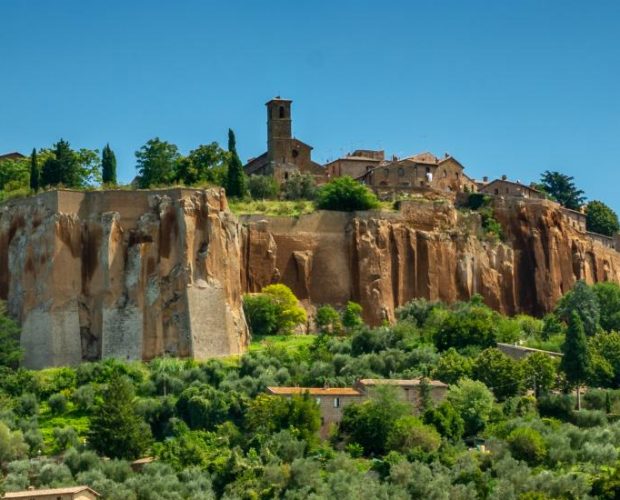
EXPLORE ALL OUR GUIDES TO THE BEST ITALIAN WINE REGIONS
Last updated: January 12, 2024
A land of lush rolling hills, ancient medieval villages, delectable wines, and sumptuous regional cuisine, Umbria bears more than a passing resemblance to its larger neighbor. Yet this captivating region is no Tuscany: Umbria offers a distinct winemaking culture with a mosaic of unique terroirs, winemaking traditions, and grape varieties. It is, unlike Tuscany, relatively undiscovered and free from the encumbrances of mass tourism. Umbria is Italy’s fourth-smallest region, moreover producing only a third as much wine as Brunello di Montalcino and Chianti Classico. However, winemakers in this landlocked part of Italy are undergoing a period of exciting change as Umbrian wines become more known and respected on the world scene. Come witness the revolution.
Vines have been cultivated in Italy’s green heart since the time of the Etruscans. However, this sophisticated and refined civilization was not the only rising power in pre-Roman Italy; Umbria is named after its first inhabitants, the Umbri tribe, who settled east of the River Tiber around 1000 BC. In addition to producing wine in terracotta pots, the Umbri were prolific builders and architects, establishing the beautiful towns of Spoleto, Gubbio, and Assisi. Nevertheless, they enjoyed an uneasy relationship with their Etruscan neighbors, jockeying for regional supremacy over this fertile landscape. However, the Romans managed to subjugate most of the Italian Peninsula in the 3rd century BC, although the bellicose Etruscans retained considerable autonomy over their province of Tuscia.
This was Umbria’s golden age of viticulture: the Etruscans controlled Orvieto during the ancient period, building magnificent cellars cut into the volcanic rock of its dramatic hilltop. These 3,000-year-old marvels can be seen today – a unique example of prehistoric refrigeration technology designed to facilitate a long, cool fermentation underground. The results in amphorae were intensely sweet, adulterated white wines that the Roman aristocracy nevertheless found utterly beguiling.
Yet, in the 5th century AD, the Roman Empire was split in two. Rome and the Western Empire became chaotic as Germanic civilizations swept Europe in the so-called Dark Ages, conquering large swathes of Italy, France, and Spain. However, the Eastern Empire remained a potent force for many centuries after the fall of Rome; the Byzantine armies retook most of the peninsula in the 6th century, establishing a stronghold in the city of Ravenna. However, the peace could not last: Italy was conquered by the Germanic Lombards in 564. They held out for over two hundred years until the papacy allied with the Frankish king Charlemagne. After ejecting the Lombards from Italian soil in 773, Charlemagne was granted the lofty title of Emperor of the Holy Roman Empire. Nevertheless, successive emperors would repeatedly clash with their papal allies as both sides attempted to assert their authority over vast European territories.
In the Middle Ages, advocates of the Holy Roman Empire (Ghibellines) and supporters of the Catholic Church (Guelps) fought endless battles to conquer central Italy. During the turbulent period, St Francis of Assisi came to prominence – St Francis is buried in the majestic Basilica di San Francesco in Umbria’s most picturesque town. Indeed, this medieval place of worship, with its geranium-hung streets and fountain-splashed piazzas, is a must-visit destination. Eventually, Umbria became absorbed into the papacy and remained controlled until the French conquest of Italy in the late 1700s. Later, part of the Napoleonic Empire, Umbria joined a united Italy in the 19th century, following the Risorgimento campaign led by Camillo Benso and Giuseppe Maria Garibaldi. A hundred years later, investment came flooding into the vineyards of Umbria, encouraged by the growing market for premium Italian wine. Its transformation continues through new styles, better viticulture, and cellar innovation.
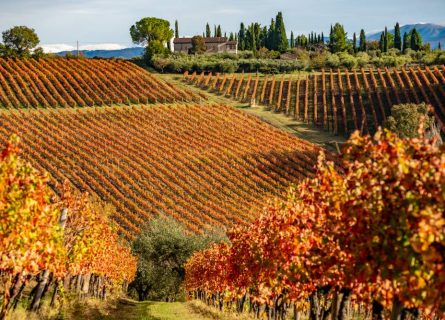
Umbria has the unique distinction of being the only Italian wine region without a coastline or international neighbor. However, its landscape and climate are very similar to that of Tuscany: gently rolling hills covered in vines, olive groves, and cypress trees. Historically, Umbria was overshadowed by the untouchable glamor of Tuscany, a region adored by tourists and oenophiles alike. Yet buyers and consumers are now discovering this beautiful and lesser-known region bordered by Marche to the east and Lazio to the southwest.
Much like the rest of central Italy, Umbria experiences mild winters and hot summers, rising to over 95°F in some places. As a result, only the higher-elevation terroirs are suitable for white wine production in the zone, particularly the hillsides that flank Lake Trasimeno, the largest body of water on the Italian Peninsula. And, like Tuscany, diurnal temperature variation (a significant difference between day and nighttime temperature) can make or break a vintage. If the nights are cool, growers can harvest ripe berries packed full of essential acidity; lower altitude terrains yield overripe grapes and flabby wines.
Today, Umbria’s greatest gift to the world of wine is undoubtedly its aromatic and full-bodied whites. Bianco di Montefalco DOC (Denominazione di Origine Controllata) is one of the lesser-known yet most promising of Umbria’s up-and-coming appellations. Located to the southeast of Perugia, the vineyards are largely planted with a mixture of Trebbiano Spoletino and Grechetto.
The best examples offer a nutty intensity and expressive bouquet of stone fruit, tomato leaf, and lemon; another smaller DOC, Spoletino, produces single-varietal wines from the grape. But, in terms of sheer volume, at least, Montefalco is dwarfed by Umbria’s most popular style, Orvieto. The vineyards are found in the southwestern corner of Umbria, extending into the neighboring province of Lazio. After a series of updates to the DOC regulations, the indigenous Grechetto and Trebbiano Toscano can be blended with French varieties like Chardonnay, often to the wine’s benefit. Nevertheless, there are still too many poor whites flying the Orvieto flag today, despite overall improvements to winemaking and viticultural management.
Fortunately, the same cannot be said for the stunning red wines of Montefalco Sagrantino DOCG. This thick-skinned red grape is undoubtedly Umbria’s finest, packed with flavor, tannin, and potential longevity. Traditionally, Sagrantino was made as a sweet passito wine, a style that has fallen spectacularly out of fashion. But in the early 1990s, Marco Caprai brought the grape to international attention by upending the formula, producing bone-dry reds of considerable power and extract. Their vivid fruit and crunchy tannins have made Montefalco Sagrantino Umbria’s most popular red, with over 800 hectares under vine.
In contrast, the Montefalco DOC appellation permits a broad palate of red and white varieties, including Sangrantino, Sangiovese, Cabernet Sauvignon, and Merlot. The best climats (vineyard sites), planted at higher elevations, yield very fragrant and elegant reds that combine the best elements of Chianti Classico and Montefalco Sagrantino: deep color, good concentration and red fruit aromatics. Like the vast majority of Umbria’s viticultural output, they are seldom overpriced. Meanwhile, the exceptional wines of Torgiano, close to Perugia, could easily be described as ‘Super Umbrians.’ The best reds are either velvety Bordeaux blends or the more traditional Torgiano Rosso Riserva DOCGs; the wines are based on a minimum of 70% Sangiovese, aged for at least three years, including six months in bottle. There is also a healthy amount of buttery Chardonnay, aromatic Sauvignon Blanc made in Torgiano, and some superior Grechetto and Trebbiano Toscano blends.
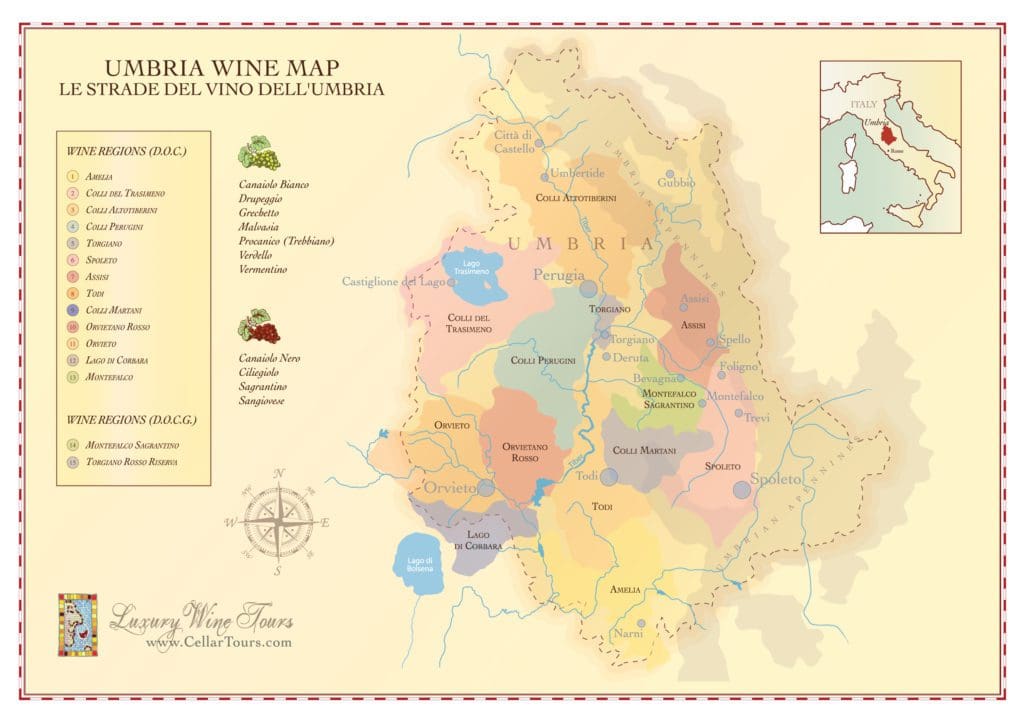
Can we neatly sum up winemaking in Umbria? Unfortunately, not – taking a census in a rabbit warren would be easier. The region boasts over 12 DOC and 6 IGP designations, with significant grape variety and wine style differences. Therefore, any attempt to pigeonhole this diverse collection of terroirs and macroclimates is bound to fail on the initial attempt.
However, there have been some broad changes to winemaking that have affected a significant number of appellations and producers in Italy. Like their Tuscan compatriots, growers in Umbria have benefited from the introduction of stainless steel and temperature control, revolutionizing the production of white wines. The old cliché of stale fruit and an oxidized, bruised apple character has been banished from the vineyards of central Italy; grapes such as Grechetto and Trebbiano Toscano (called Procanico here) yield far better wines at lower temperatures, with more fruit and precision. However, the practice of blending different grapes has remained strong throughout Umbria’s long wine history, with the notable exception of Montefalco Sagrantino DOCG. Most of the best Umbrian reds are treated to a spell in wood, varying from 100% new French barrique to old Slavonian barrels. There has also been a return to amphorae and concrete eggs in certain quarters.
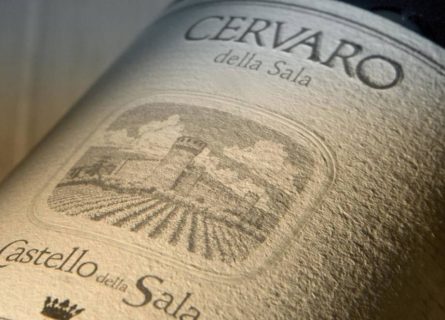
Italy’s only landlocked region has wine traditions that date back over 3,000 years. Yet, like so many Italian vineyards, the story of the mid-20th century was one of apathy and decline. Take Orvieto, for example, a wine-growing area with a very long and proud legacy of producing unique white wines from the Grechetto grape. Italy’s upper classes were beguiled by these concoctions of fruit, sugar, and acid for centuries – Orvieto was once regarded as one of Europe’s greatest dessert wines. But then the fashions changed, and consumers demanded crisp, dry whites at affordable prices. Alas, Orvieto’s conversion to dry encompassed a slide into mediocrity, with large volumes of high-yielding Trebbiano Toscano substituting the vastly superior Grechetto in the blends. Stripped of its character and stymied by greed, the fortunes of this supposed leader of Umbrian wine floundered.
Thankfully, several pioneers and innovators recused Umbria’s ailing reputation in the late 1900s. They included the genius Dr Giorgio Lungarotti, who, on his estate at Torgiano, was the first to prove that Umbria could make red and white wines of depth and refinement – a rival to the best of Tuscany. His daughters, Teresa and Chiara, continue his legacy of crafting terroir-driven wines from a judicious mix of imported and local grapes.
However, Lungarotti was not the only winemaker to shake things up in the vineyards of Umbria. The Antinori family has been a staunch proponent of the region, founding the Castello di Sala estate in the 14th century. Updating this ancient treasure for the modern age, the oenologist Renzo Cotarella started marketing a revolutionary range of white wines in the 1980s, including a barrel-fermented Chardonnay that electrified the critics. Cotarella also won high praise for the signature cuvée Cervaro della Sala, a blend of Chardonnay and Grechetto that displays a singular purity and depth rarely seen in Umbrian whites. It is now regarded as one of Italy’s greatest white wines, and with just cause!
Of course, further milestones have been achieved since the first pioneers got involved. Today, Umbria markets an eclectic mix of reds and whites from grapes, both local and imported, matching specific varieties to its myriad of diverse terroirs. There are skin-contact whites, biodynamic reds, and some delicious traditional-method fizz. Its key appellations remain important, although many innovators are fully using the IGT frameworks’ freedom. Umbria, once a pale shadow of the Tuscan wine scene, has arrived.
Chardonnay is a green-skinned grape varietal native to the Burgundy wine region in France and one of the most popular varieties worldwide.
Find out moreGrechetto is a white grape variety native to the central regions of Italy, particularly Umbria, and is used to make a range of wines
Find out moreThe sauvignon blanc grape varietal, originally from the Bordeaux region of France, is now one of the world's most loved white varieties.
Find out moreExperience Trebbiano Toscano's Renaissance: Aromatic & Fresh Bianco Toscana IGT from Petrolo. The Future of Italian White Wine
Find out moreCabernet Franc grape is a close relative of Merlot and Cabernet Sauvignon and is the principal blending grape used in Bordeaux.
Find out moreDiscover the irresistible allure of Cabernet Sauvignon—a worldwide favorite with robust, dark-bodied flavor. Unleash your wine journey today!
Find out moreMerlot is the most cultivated grape in Bordeaux and closely related to Cabernet Franc
Find out morePinot noir is a light-bodied red wine varietal closely related to the Vitis vinifera grape and produces the most sought-after red wines in the world.
Find out moreSagrantino is a red grape from Umbria, Italy, primarily cultivated in Montefalco. Its origin is unclear, possibly linked to religious or food festivals. Initially used for sweet wines, it shifted to dry styles in the 1970s. Known for high tannin levels, it produces dark, long-lasting wines with black fruit and spicy notes, epitomized by the renowned Sagrantino di Montefalco.
Unearthing Sangiovese: Italy's Ancient Grape with a Complex History. Explore its journey from Etruscans to modern-day excellence.
Find out moreSyrah is dark-skinned and perhaps the most underrated of the 'noble' red grape varieties.
Find out moreAlthough it may be invidious to say so, Umbrian cuisine is every bit as exciting – and varied – as that of its more famous neighbor. Every city and subregion has its specialties: strangozzi alla spoletina, a thin fettuccine-like pasta with tomato, garlic, and chili pepper, is the dish of choice in pretty Spoleto. But there is plenty more to whet your appetite: black truffles from Norcia, wild boar slowly cooked in Sangiovese, and Regina alla porchetta (roasted carp stuffed with garlic, fennel, and herbs). Wash it down with a Torgiano Riserva and marvel at that spectacular view. Mealtimes in Umbria are always a leisurely affair.
A Guide to the Gastronomy and Cuisine of Umbria: Read more

Explore the Charms of Orvieto, Italy: Ancient History, Gothic Beauty, and Culinary Delights Await. Discover Your Next Adventure!
Read more
Assisi: A Medieval Marvel Blending St. Francis' Legacy, Stunning Architecture, and Rich History in Italy's Heart.
Read more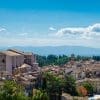
Discover Perugia, the Heart of Umbria, Where History Meets Modernity. Explore a Vibrant City Known for Its Gourmet Scene and Cultural Riches.
Read moreIf you would like us to customize an exclusive luxury tour, contact us and let us know your travel plans. We offer luxury food and wine tours for private groups of a mininium two guests. In addition, all of our private, chauffeured tours are available year-round upon request.

